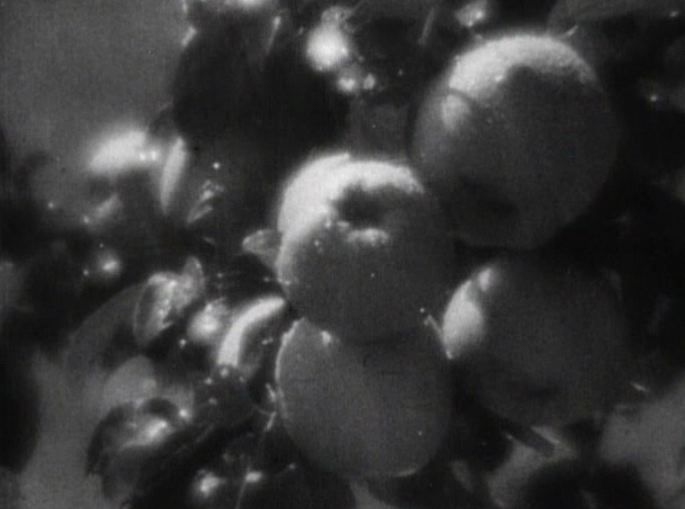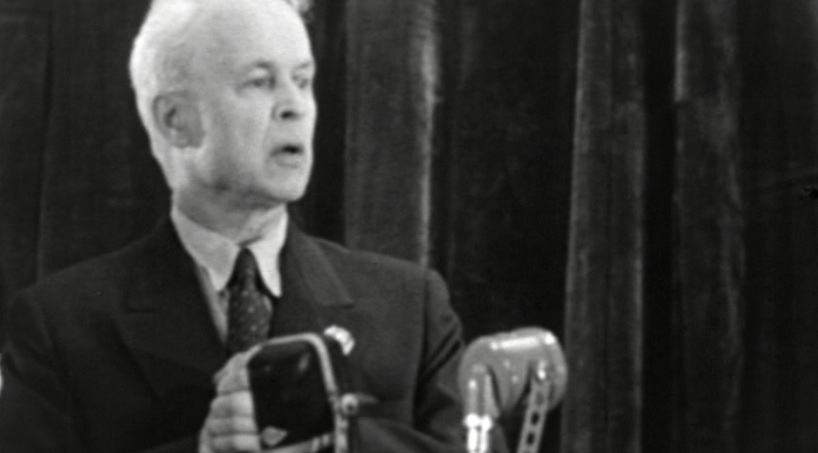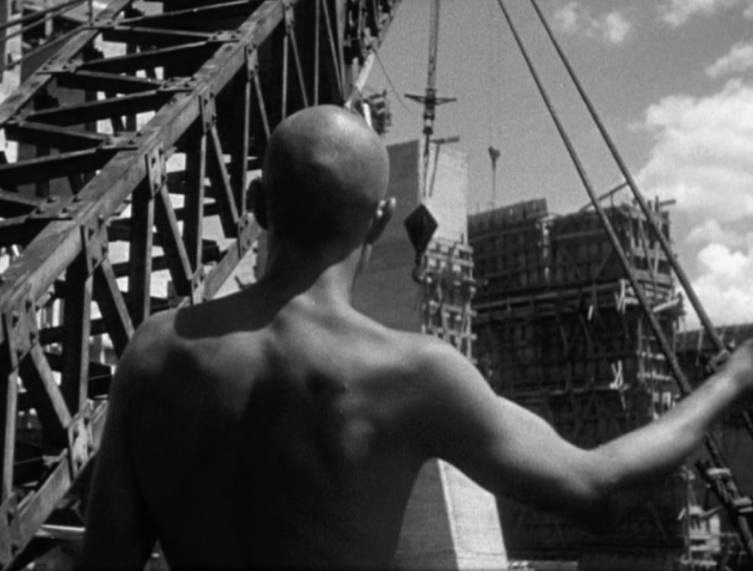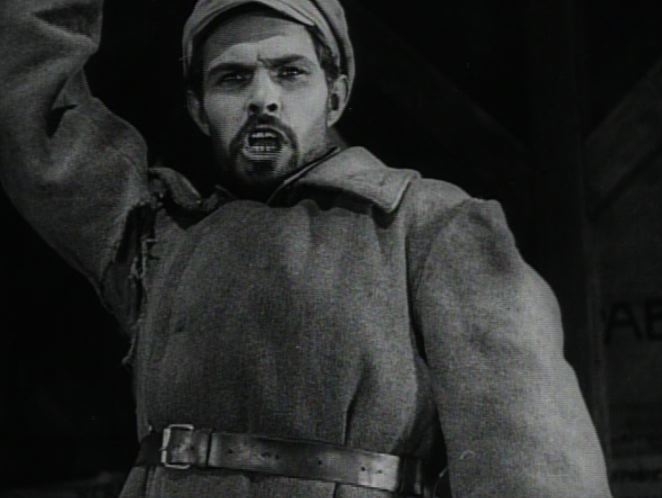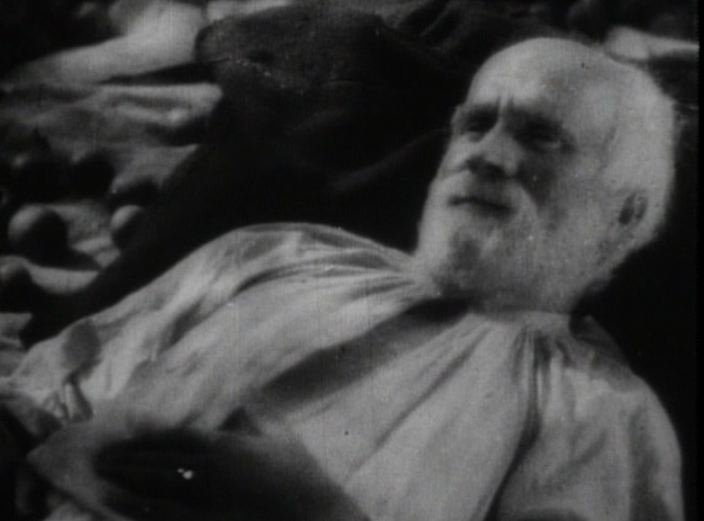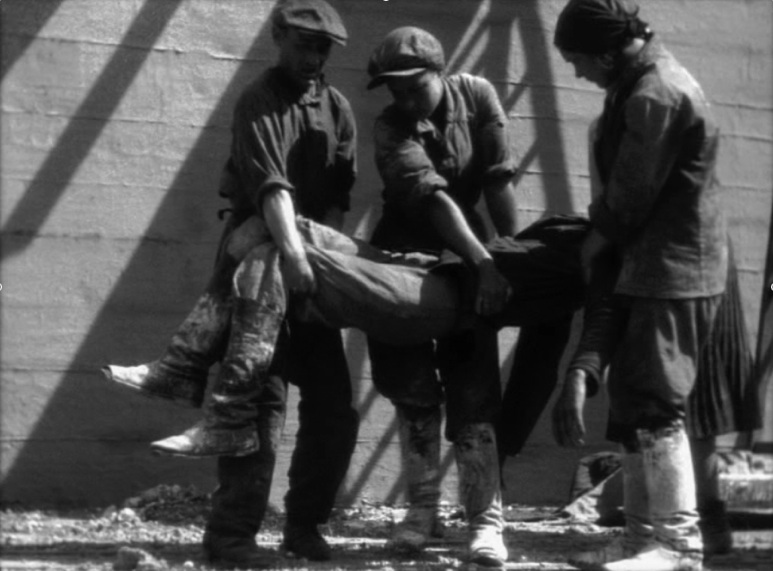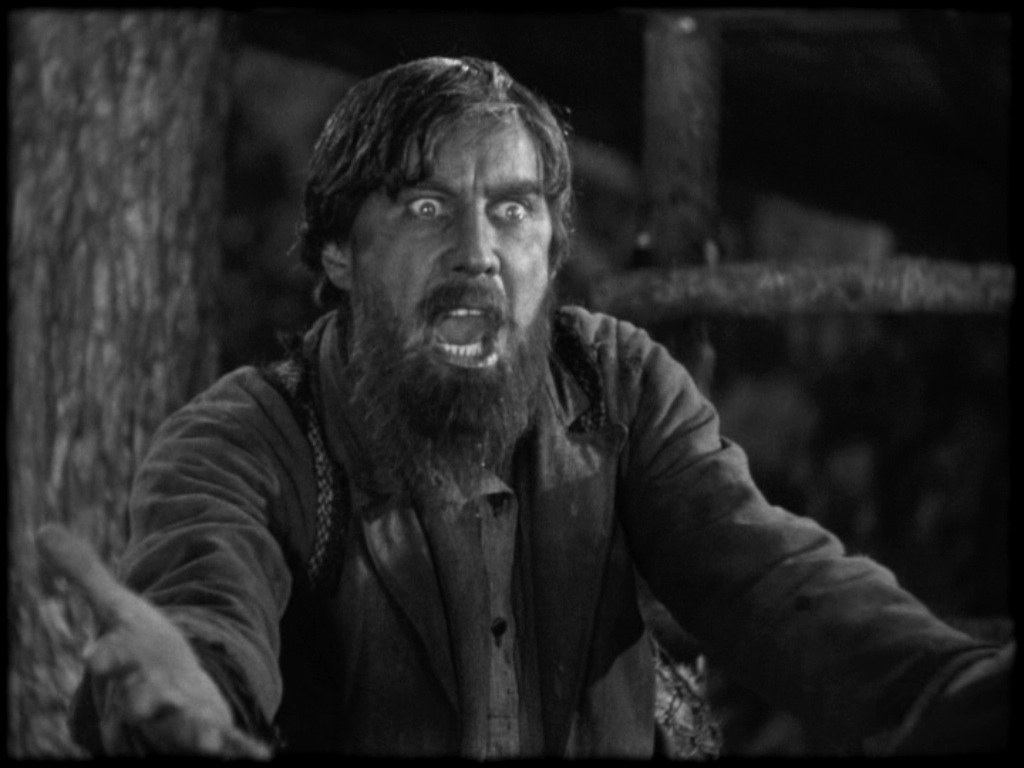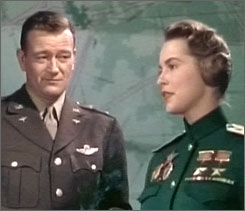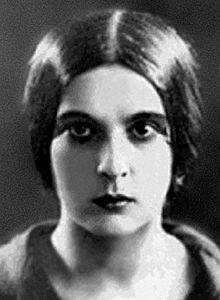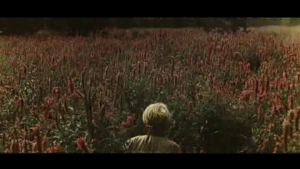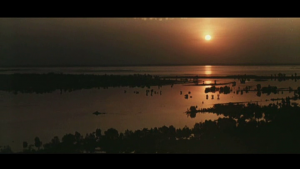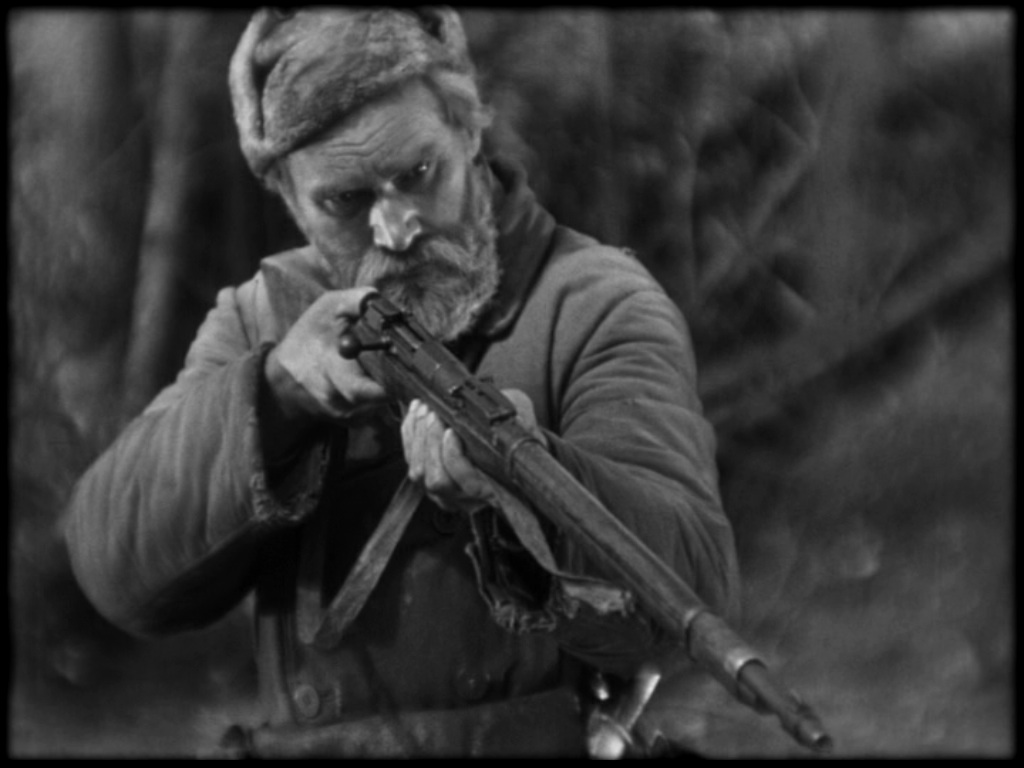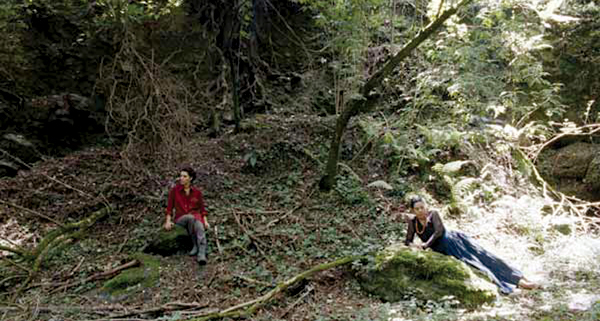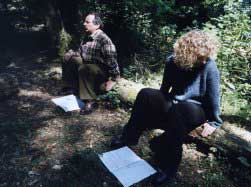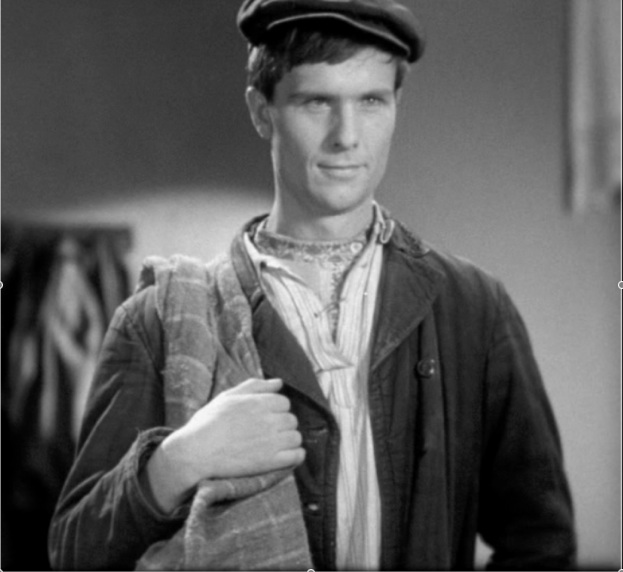From the June 7, 2002 Chicago Reader. This is also reprinted in my book Essential Cinema. — J.R.
Landscapes of the Soul: The Cinema of Alexander Dovzhenko
When I speak of poetry, I am not thinking of it as a genre. Poetry is an awareness of the world, a particular way of relating to reality….Think of Mandelstam, think of Pasternak, Chaplin, Dovzhenko, Mizoguchi, and you’ll realize what tremendous emotional power is carried by these exalted figures who soar above the earth, in whom the artist appears not just as an explorer of life, but as one who creates great spiritual treasures and that specific beauty which is subject only to poetry. Such an artist can discern the lines of the poetic design of being. He is capable of going beyond the limitations of coherent logic, and conveying the deep complexity and truth of the impalpable connections and hidden phenomena of life. — Andrei Tarkovsky, Sculpting in Time
It is possible that we are still in a pre-historic stage of cinema, for the great history of cinema will begin when it leaves the frame of ordinary artistic representation and grows into a tremendous and extraordinarily encompassing perceptive category. — Alexander Dovzhenko, 1933
Ukrainian writer-director Alexander Dovzhenko may be the most neglected major filmmaker of the 20th century. He’s never come close to receiving his due, in this country or elsewhere, in large part because his fervent, pantheistic, folkloric films develop more like lyric poems, moving from one stanza to the next, than like narratives, proceeding by way of paragraphs or chapters. The world they describe is one of Gogol-esque horses that sing or reprimand their owners, noble cows, glistening meadows, wily cossacks, dancing peasants, declamatory speeches by wild-eyed individuals, close-ups of daisies alongside proud women with similarly open faces, vast reaches of empty sky over fields of waving wheat — a vision of a natural order that paradoxically seems both brutal and harmonious. It’s poetry in part because it’s a paean to existence and because it sings about rather than recounts its details. But if satire is what closes in New Haven, lyric poetry is what never opens.
All of Dovzhenko’s major films include events — in the wild montage flurries of Arsenal they’re virtually nonstop — and some of them are explosive, sometimes literally. Events can’t be consumed the way narratives can be, because their very nature tends to confuse and confound us: they are splintered experiences that generally become coherent only through the continuity and logical progression of storytelling.
Of the dozen Dovzhenko films showing at the Gene Siskel Film Center this month — more of his works than have ever been screened in Chicago and possibly more than will ever be shown here again — at least four are jaw-dropping masterpieces: Arsenal (1929), Earth (1930), Ivan (1932), and Aerograd (1935). The middle two are showing this week, the first and last next week. It’s regrettable that each of the silent films in this retrospective, including Arsenal and Earth, is showing only once, but it’s also understandable given the usually small turnouts for silent films as well as the cost of hiring a pianist for each screening. (His greatest film, Earth, is playing on Friday at 6, his worst, the unfinished Farewell America, at 8.)
A silent-film syntax, including a bold use of intertitles, persists in Dovzhenko’s work up through Michurin (1948), though it would be wrong to conclude that this made any of his sound films old-fashioned in their own time. Ivan and Aerograd aren’t just silent films with music and sound effects. The first resembles an orchestral suite divided into six sections; the second is clearly operatic, with the sounds of plane engines used as effectively as the voices.
There are also astonishing things in Zvenigora (1927), which Dovzhenko once called “a catalog of all my creative possibilities,” and Shchors (1939), which has a remarkable opening — though they’re not in the same league as the other four. (I saw an untranslated version of Shchors, and I haven’t yet seen either of the documentary features in this series, the 1943 Battle for Soviet Ukraine and the 1944 Victory on the Right Bank Ukraine.) Don’t imagine that you can get the measure of any of these films without seeing a 35-millimeter print on a big screen; anyway, only a couple of them are readily available in any other format (there’s a good print of Arsenal with a good score on video, a mediocre print of Earth with a bad score on video and DVD).
Are they propaganda films? Yes and no; in many ways Dovzhenko makes the category almost meaningless. Most of them were financed by the Soviet state, and they were all made in part for propaganda purposes, though more often than not these clearly avant-garde films didn’t achieve that objective — which was bound to make some bureaucrats furious. Earth, a film about the arrival of collectivized farming in a Ukrainian village, was received so poorly in the early 30s that Dovzhenko’s father was thrown out of a collective farm as a consequence.
Ivan got Dovzhenko into plenty of trouble as well. There are three separate characters named Ivan in the film, a celebration of the building of a huge dam on the Dnieper River that doesn’t bother to show us the completed dam. One of these Ivans has a gruff, illiterate father (Stepan Shkurat) who’s an unapologetic slacker and a hilarious bullshit artist. He spends his time idly fishing at a construction site where the rest of the people are working their butts off; he boasts directly to the camera that he’s contemptuous of the very notion of labor, brandishing the back of his neck for all to see. Without question, the film adores this old coot more than anyone else in the picture. And when we later see a Soviet army marching, the sky is so vast and the soldiers so tiny, crawling across the lower edge of the screen like bugs, that it’s hard to know exactly what’s being extolled. If this is propaganda, we need to ask on behalf of what.
Dovzhenko was born in 1894 in a town by the Desna River, the son of an illiterate Ukrainian cossack farmer who also had to work as a driver and pitch burner to feed his family. Alexander had 13 siblings, and only one of them survived into adulthood, a sister who became a doctor. “I still cannot bear to look at funerals,” he wrote in the 30s, “and yet they pass through all my scripts and all my pictures, for the question of life and death affected my imagination when I was still a child and left its imprint on all my work.” Having just seen or reseen half a dozen of his films, I consider this an understatement, because I can’t think of any other filmmaker who’s dealt as comprehensively, as beautifully, or as profoundly with death — or who has so many things to say about what it means to be alive.
I’m thinking of a man in Arsenal who’s missing half of his teeth; blackened by smoke, he’s attacked with laughing gas at the battle front and laughs hysterically while a nearby corpse grins hideously. I’m also thinking of the blissful, peaceful death of the grandfather in harmony with rural nature in Earth, a loving portrait of Dovzhenko’s own grandfather, and the woman in the same film who tears off all of her clothes in hysterical grief when her boyfriend is shot; of the worker in Ivan who falls to his death during the dam construction (an event signaled by a plume of black smoke) because of poor planning; of the remarkable montage of the man’s protesting mother rushing through ten bureaucratic doors in quick succession; of the many deaths in Aerograd of fierce antagonists in a Siberian forest (some of these deaths prefaced by the equivalent of arias); of the death of the title hero’s wife in Michurin, occasioning one of the only bursts of raw (as opposed to “approved”) emotion in that film. This is far from an exhaustive list of the ways death is depicted in Dovzhenko’s work, but it suggests the affective range.
By the time he was 20, Dovzhenko was working as a science teacher, and by his own account, when the 1917 Russian Revolution came, though he hadn’t yet heard of Karl Marx, he was “happy as a dog let off a chain, sincerely believing that now all men were brothers, that everything was completely clear; that the peasants had the land, the workers had the factories…the Ukrainians had Ukraine, the Russians had Russia; that the next day the whole world would find out about this and, struck with our vision, would do likewise.”
He still felt that way when he started making his own movies — after a brief stint as a highly skillful and inventive commercial director (see, for instance, his 1926 slapstick comedy Love Berry and his 1927 thriller Diplomatic Pouch, playing together on Saturday, June 29). His own films were in part the ecstatic expressions of a sometime painter, cartoonist, and diplomat, but they were also tragic reflections on the price that has to be paid for any revolutionary change, inflected by turmoil, anguish, and even horror. And few films anywhere are more exalted and passionate in their feeling for people. The late Russian film historian Jay Leyda, who met Dovzhenko in Moscow in 1934, recalls him reading aloud his script of Aerograd: “His voice, as powerful and convincing as I imagined Mayakovsky’s must have been, filled his hotel room to the bursting point….When I later watched him work at Mosfilm I saw that his relation to actors was to infect them with his immense enthusiasm in the same way that he swept me off my feet with his reading.”
It seems inevitable that the cold war and its legacy would prevent us from seeing any Soviet filmmaker clearly, just as it prevented any Soviet filmmaker, Dovzhenko included, from seeing us. Dovzhenko’s unfinished final film, the 1950 Farewell America, is stridently kitschy anti-American propaganda in chromolike color that was instigated as well as halted by Stalin, then “completed” only seven years ago with documentary material about its making and unmaking.
If it were less campy and more accomplished as entertainment, Farewell America might qualify as a sort of anti-Ninotchka, the reverse of Lubistch’s anticommunist comedy with Greta Garbo. Instead it’s a grimly fascinating demonstration that the communist misreadings of Americans were as grotesque as some of our own notions about “Russkies” during the same period. The paranoia of that era certainly seeps through the plot details, and given the limited choices available in such a climate, the worst thing that can be said of Farewell America is that not even the on-screen “expert” who recounts the story of Dovzhenko preparing and partially shooting and editing it (eight versions of the script, half as many drafts of the cutting continuity) knows whether the film was sincere or hypocritical. But we soon come to the horrible realization that it makes no difference anyway.
To a lesser extent, we also find ourselves in the dark about Dovzhenko’s precise relation to his material in Michurin, a film that provides the missing link between the personal, operatic grandiloquence of Aerograd and the anonymous opera buffa style of Farewell America. When he concludes one sequence of this color biopic about a famous botanist, a film celebrating agriculture, with an exalting shot of an electrical tower, is this a heartfelt or a sarcastic detail? On the face of it, this sort of poker-faced platitude makes bad Stalinist art look worse than bad Hollywood art of the same period — even if the patchy appearance of Michurin periodically suggests the even more protracted retooling of a Howard Hughes opus like Jet Pilot — but this may be only because we’re better equipped to read the nuances of Hollywood junk. (We certainly know that directors working under either Hughes or Stalin got more interference when the big shot took a personal interest in the filmmaking — as Stalin did with Shchors, Michurin, and Farewell America and Hughes did with the equally propagandistic Jet Pilot.)
This traveling retrospective is close to complete in terms of Dovzhenko’s work as a director; the most conspicuous absences are the five features based on some of his unrealized scripts and directed by his widow, Julia Solntseva — an absence clearly ascribable to the cold war and its legacy. None of these films has ever been subtitled in English, but I’ve seen one of them dubbed into French, Chronicle of Flaming Years (1961), and three of them untranslated: Poem of an Inland Sea (1958), The Enchanted Desna (1965), and The Golden Gate (1969). (The only place I know of where these films have been shown in recent years is Paris.) I’ve missed only Ukraine in Flames (1968).
Dovzhenko was all set to direct Poem of an Inland Sea when he died in 1956, yet I believe that all five of these features say “directed by Alexander Dovzhenko” in their credits, following the Russian tradition of paying homage to a master. (I’m told that the direction of many theater productions was credited to Konstantin Stanislavsky long after he died, in 1938.) Interestingly, even though Michurin was directed by Dovzhenko, its credits read, “Script and production by Alexander Dovzhenko, directed by Julia Solntseva” — probably because Dovzhenko wanted to protest the multiple revisions Stalin demanded in the film and in the play that it was based on (Life in Bloom, also by Dovzhenko), and perhaps also because his wife stepped in to take credit as a face-saving gesture. (A silent-film actress, Solntseva starred in the 1924 feature Aelita six years before she met Dovzhenko and worked as his assistant on most of his pictures, starting with Earth, in which she also acted.)
The greatest Solntseva film by far is Desna — a rapturous evocation, in 70-millimeter and stereophonic sound, of Dovzhenko’s rustic youth that made first place on Jean-Luc Godard’s ten-best list for 1965 — though a friend I saw it with who understood Russian told me its narration is full of Stalinist claptrap. And it’s certainly difficult to reconcile Solntseva’s desire to honor and extend her husband’s legacy in her final tribute, Golden Gate, with her systematic practice of brutally cropping his compositions to make them conform to a ‘Scope format. Still, Desna gives Dovzhenko’s aesthetics blockbuster proportions, which made seeing it one of the most pungent experiences I’ve ever had in my moviegoing life.
Cold war thinking — which is hardly behind us — split the world neatly into good guys and bad guys. Yet the bad guys weren’t all the same, even though the delusion that they were still clouds current thinking (cf the “axis of evil”). Most accounts we have of Dovzhenko’s life and work are found in discussions of Russian cinema, but the man wasn’t Russian. He was Ukrainian, and he fought against the Russians during the revolution — and as a consequence is said to have lived under surveillance by the Soviet government for the rest of his life.
People also have a bad habit of associating vanguard art with cities regardless of where they’re from themselves — not because it all comes from cities but because so much of their access to it and understanding of it does. To the best of my knowledge, Dovzhenko retrospectives aren’t screened in the sticks anywhere in the world, though French television offered a retrospective a few years ago.
Aerograd was released here in 1936 under the title Frontier and had an enormous impact on American viewers ranging from James Agee to Elia Kazan — but that was during a period when communist art was still considered important here. The film concerns the building of a city in the far east, on the shores of the Pacific — a city that, like the dam in Ivan, we never see, though in this case we don’t even see the construction start. One thing that’s awesome as well as heartbreaking in all of Dovzhenko’s best work — and even in some of his worst, like Michurin — is its almost limitless faith in the future, which plants him in a different universe from the one we know.
In recent years it’s been impossible to see the films of Jean-Marie Straub and Danièle Huillet in most major cities because they’re considered too difficult. But when I recently caught up with their latest one, Operai, contadini (“Workers, Peasants”), at the Buenos Aires International Festival of Independent Film, I discovered that the only “difficult” thing about it was its refusal to tell a story in any ordinary sense. It concerns a group of Italians in a lush forest reciting or reading portions of a novella by Elio Vittorini, and I was riveted by the extraordinary way their deliveries were directed and orchestrated as well as by the beautiful ways that the characters were framed and filmed (most often from slightly low angles) and that their voices were recorded in relation to the natural setting. What they were saying wasn’t esoteric — how to make risotto was one of the topics — and the film qualifies as heroic portraiture because it’s concerned more with who and where its human subjects are than with what they do as characters.
The same thing is true of Dovzhenko’s films, where the low angles are more extreme and generally make the subjects even more monumental. And the passage of time in films such as Arsenal and Ivan is often conveyed oddly and ambiguously — because the sheer existence of the people shown counts for much more than anything that might make them part of a story. One astonishing sequence in Ivan does nothing but introduce us to various workers, each cited by name and profession in a separate intertitle, and it’s characteristic of Dovzhenko’s special genius to make such a succession of faces and physiognomies so rich and intense that it wouldn’t occur to us to think of any part of it as minimalist. There’s a solidity and fullness to each person filling the screen that arguably annihilates narrative and ideology alike, leaving only poetry.


